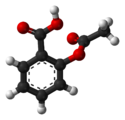Aspirin
 | |
 | |
| Clinical data | |
|---|---|
| Pronunciation | acetylsalicylic acid /əˌsiːtəlˌsælɪˈsɪlɪk/ |
| Trade names | Bayer Aspirin, many others |
| Synonyms | 2-acetoxybenzoic acid acetylsalicylate acetylsalicylic acid O-acetylsalicylic acid, Aspirin (BAN UK), Aspirin (USAN US) |
| AHFS/Drugs.com | Monograph |
| MedlinePlus | a682878 |
| License data | |
| Pregnancy category |
|
| Routes of administration | by mouth, rectal, lysine acetylsalicylate may be given intravenously or intramuscularly |
| ATC code | |
| Legal status | |
| Legal status |
|
| Pharmacokinetic data | |
| Bioavailability | 80–100%[2] |
| Protein binding | 80–90%[1] |
| Metabolism | Liver, (CYP2C19 and possibly CYP3A), some is also hydrolysed to salicylate in the gut wall.[1] |
| Elimination half-life | Dose-dependent; 2 h to 3 h for low doses (100 mg or less), 15 h to 30 h for large doses.[1] |
| Excretion | Urine (80–100%), sweat, saliva, feces[2] |
| Identifiers | |
| |
| CAS Number | |
| PubChem CID | |
| IUPHAR/BPS | |
| DrugBank | |
| ChemSpider | |
| UNII | |
| KEGG | |
| ChEBI | |
| ChEMBL | |
| PDB ligand | |
| ECHA InfoCard | 100.000.059 |
| Chemical and physical data | |
| Formula | C9H8O4 |
| Molar mass | 180.158 g/mol |
| 3D model (JSmol) | |
| Density | 1.40 g/cm3 |
| Melting point | 136 °C (277 °F) |
| Boiling point | 140 °C (284 °F) (decomposes) |
| Solubility in water | 3 mg/mL (20 °C) |
| |
| |
| (verify) | |
Aspirin (also known as acetylsalicylic acid) is a drug. It is most commonly used as a pain killer to treat headaches, toothache, period pain. It is also used to reduce fever, flu-like sumptoms or colds, and inflammation.[3] It usually starts working 20-30 minutes after taking it.
It has an anti-platelet effect, which means it reduces the number of platelets in the blood, which in turn reduces blood clotting. Because of this, it is used to treat heart attacks. Low-dose aspirin is sometimes prescribed to people who are at a greater risk of heart attacks or stroke[4]
Aspirin is one of the most-used medical drugs in the world and is on the World Health Organization's List of Essential Medicines[5]
Children under 16[3] (used to be 12) can develop Reye's syndrome from using asprin. This causes the liver to become fatty and not work properly. The brain may also become enlarged. Reyes syndrome can be fatal or lead to permanent brain damage, but most children survive with treatment.
There are possible side-effects to this drug. For example, large amounts can damage the kidneys.
People with lung, kidney disease, gout, hyperuricemia (high amounts of uric acid in the blood), hemophilia, diabetes, or high blood pressure should not take aspirin except on the advice of a qualified medical professional. People who are allergic to asprin, or to ibuprofen or naproxen should not take asprin. People with asthma, where attacks are brought about by aspirin, should avoid using any anti-inflammatory drugs based on it.
Aspirin was invented in Germany in 1897. Bayer has a trademark on the brand name "aspirin" in 80 countries. But in other countries, "aspirin" is the common name for the drug.
References[change | change source]
- ↑ 1.0 1.1 1.2 Brayfield, A, ed. (14 January 2014). "Aspirin". Martindale: The Complete Drug Reference. Pharmaceutical Press. Retrieved 3 April 2014.
- ↑ 2.0 2.1 "Zorprin, Bayer Buffered Aspirin (aspirin) dosing, indications, interactions, adverse effects, and more". Medscape Reference. WebMD. Archived from the original on 7 April 2014. Retrieved 3 April 2014.
- ↑ 3.0 3.1 "About aspirin for pain relief". nhs.uk. 2021-09-17. Retrieved 2024-05-26.
- ↑ "About low-dose aspirin". NHS. 16 December 2021.
- ↑ Organization, World Health (2023). "The selection and use of essential medicines 2023: web annex A: World Health Organization model list of essential medicines: 23rd list (2023)". WHO. 23.
